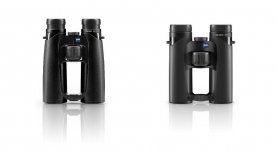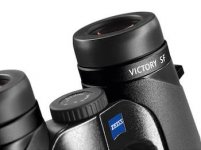The quality of the mechanical components – particularly the housing and the moving parts – are the guarantee for decades of protection and correct alignment of the optics.
When glasses are worn, the dioptre compensation is normally set to zero because the glasses should correct any differences between the eyes, but in practice it is advisable to periodically perform the dioptre adjustment check, to ensure you obtain maximum performance and enjoyment from your ZEISS instrument. This is for several reasons: firstly, our eyes can change more rapidly than we change our glasses. Secondly, our glasses may not be quite perfect as the questions asked by our optician (typically, ‘is this lens sharper or the next one?’) become increasingly difficult to answer correctly near the end of the consultation, and spectacle lenses are made according to tolerances like all manufactured products, and some lenses may be better made than others. Finally, with some binocular brands it may be unwise to assume that when the adjuster is set to zero, the dioptre mechanism is actually in the zero position. However, performing the dioptre adjustment is so simple it is worthwhile to do so in order to ensure none of these possibilities interfere with your enjoyment of your binoculars.
Housings
ZEISS binocular optical tubes are made from a range of superior materials depending on the model and these range from magnesium alloys, through aluminium alloys to glass-reinforced polymers. Rubber armouring provides additional protection for binoculars and spotting scopes, ensures a secure grip, and absorbs sounds should the instrument accidentally hit something. On all products, ZEISS selects an optimal mixture of materials to permanently package high-performance optics for use under the toughest conditions. All ZEISS roof prism binoculars are filled with nitrogen gas, which prevents ‘fogging’ of the inside of the binoculars.Focusing
In order to obtain sharp images at various distances, in all ZEISS roof-prism binoculars, a focusing lens group (usually just a single lens) is moved mechanically by rotating the focus wheel. This movement takes place totally internally, so there is no change in the internal volume (and therefore no ‘pumping’ of air in and out) and since, thanks to the use of appropriate seals, there is no exchange with outside air, i.e. dust and moisture cannot penetrate the housing. This is the only way to manufacture binoculars which are fully watertight.Dioptre Adjustment
Binocular devices feature dioptre compensation to correct for the difference in performance of the left and right eyes. Although this adjustment may be satisfactory for many years, it is a fact that as we get older our eyes change, and sometimes the left eye and right eye change differently, so it is worthwhile checking this adjustment from time to time, especially in later life.When glasses are worn, the dioptre compensation is normally set to zero because the glasses should correct any differences between the eyes, but in practice it is advisable to periodically perform the dioptre adjustment check, to ensure you obtain maximum performance and enjoyment from your ZEISS instrument. This is for several reasons: firstly, our eyes can change more rapidly than we change our glasses. Secondly, our glasses may not be quite perfect as the questions asked by our optician (typically, ‘is this lens sharper or the next one?’) become increasingly difficult to answer correctly near the end of the consultation, and spectacle lenses are made according to tolerances like all manufactured products, and some lenses may be better made than others. Finally, with some binocular brands it may be unwise to assume that when the adjuster is set to zero, the dioptre mechanism is actually in the zero position. However, performing the dioptre adjustment is so simple it is worthwhile to do so in order to ensure none of these possibilities interfere with your enjoyment of your binoculars.





